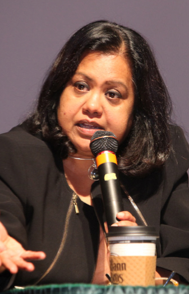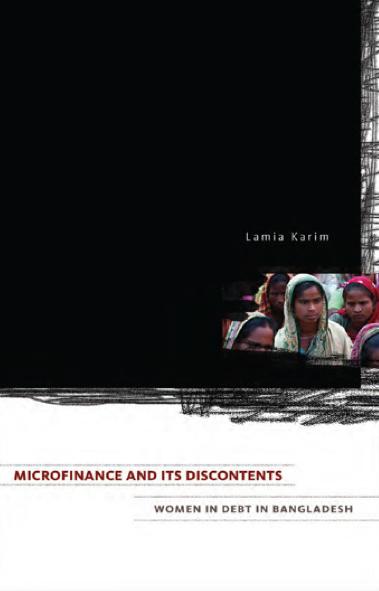Microfinance—the practice of loaning a small amount of money to individuals without collateral—has been touted in recent years as a panacea for global poverty. It first became popular in the 1970s when economist Muhammad Yunus experimented with loaning $27 to a group of poor Bangladeshis, who were actually able to turn a tiny profit with the extra cash. Yunus went on to foundGrameen Bank, which soon issued millions of dollars in microloans to the poorest of Bangladesh.
 Over the past decade hundreds of institutions modeled after Grameen Bank have sprung up to offer loans to poor people all over the world. The United Nations declared 2005 as the year of microfinance and in 2006 Yunus received the Nobel Peace Prize for his work. Women have become the major recipients of such loans because banks claim they are the most reliable borrowers, and many financial backers have a special interest in female empowerment.
Over the past decade hundreds of institutions modeled after Grameen Bank have sprung up to offer loans to poor people all over the world. The United Nations declared 2005 as the year of microfinance and in 2006 Yunus received the Nobel Peace Prize for his work. Women have become the major recipients of such loans because banks claim they are the most reliable borrowers, and many financial backers have a special interest in female empowerment.
However, Yunus and Grameen Bank have recently come under attack for questionable business practices, and this in turn has dimmed the luster of microfinance. But there have actually been skeptics all along.
Lamia Karim is one of them. Karim, an associate professor of anthropology at the UO, grew up in Dhaka, Bangladesh. She has long harbored suspicions that microfinance is not a silver bullet for ending poverty, and in 1998 she returned to her home country to research the actual impact of these loans on the women and families who receive them. Further research in 2007 helped her document the often grim reality.
The title of her new book, Microfinance and Its Discontents (University of Minnesota Press, 2011), leaves no doubt as to her stance: Karim has become a much-quoted critic (Wall Street Journal, National Public Radio) of the once-lauded practice ofmicrofinance. Listen to interviews on NRP and Jefferson Public Radio.
Q: The premise of your book is that microfinance has actually had a negative impact on the lives of many women who received loans. Why doesn’t microfinance work?
LK: If you give small loans to people who do not have any marketable skills, or are not engaged in business, they are going to become consumers, not producers. The people targeted for microfinance loans are very, very poor. You give them enough money to buy, say, four chicks, and the idea is they can raise these chicks as chickens and then sell the chickens, or sell their eggs. But what if the chicks die, or the family cannot afford chicken feed? Sometimes the family will pressure the women to take the loan—“Just get the money, we’ll figure out how to pay it back somehow”—but really, they have no way to pay it back because they are so poor. We should be always very skeptical when people start targeting the poor with debt in the name of empowering them.
Q: Does microfinance ever work?
LK: Microfinance works when the loan is given to someone who has a small operation, say a bike shop. Then maybe he or she could expand this shop by hiring another person or buying some equipment. But these kinds of people usually don’t get loans from institutions like Grameen Bank because, if you have a little shop, you are not the poorest of the poor, which is who the banks are supposed to lend to.
Q: Many of the lending institutions claim 98–99 percent loan recovery rates. How is that possible?
LK: These rates are very high, by any standard. Either all these poor people are becoming successful entrepreneurs or there is another story. What I’ve found is that the lenders will do whatever it takes to recover the money. Often their techniques involve shaming the women who are in debt. If these methods of humiliation do not work, they will sell items owned by the family. Occasionally they will give the woman another loan to cover her old loan, putting her further into debt. Basically, the return rate statistics are not a measure of the industry’s ability to solve poverty.
Q: You talk a lot about shaming techniques in your book. What does this mean?
LK: You have to understand Bangladeshi culture to recognize how important this is. In rural Bangladesh, your status is very important. If you have been shamed in public—for instance, if somebody calls you a liar in public—it’s a big deal.

Women are the custodians of a family’s honor and shame. By shaming the woman, you shame the whole family. Also, women are viewed as outsiders to a family unit, because they are brought into the family through marriage. This makes them a target. When a woman has defaulted on a payment, someone associated with the bank might come inside the home and start telling her she owes money. The mother-in-law witnesses it and says, “You have shamed my family and my son by bringing these outsiders it.” These are very poor women. They cannot pay back her part of the loan. So, they went to her house to get the bed. They could not get it through the doorway so they cut a hole in the back of the house—these houses are made of tin and straw—and took the bed out that way.
These are the kinds of hidden stories I have found, not cheerful stories of poor people becoming entrepreneurs overnight.
Q: Why are women targeted as loan recipients?
LK: When microloans first started to be given out, men were given loans. But it was harder to recover loans from men.
Men could leave. Women are more reliable because the social structure doesn’t allow them to run away. If a woman defaults on her loan, the lenders can always find her. She is home. But this doesn’t mean it is the woman who controls the money. She gets the money, goes home and usually turns it right over to her husband or to her son. Yet it is still the woman who is obliged to pay back the loan. Microfinance institutions are able to insert themselves into this cultural structure by targeting women as borrowers, and then manipulating the social roles of the women to make sure the loan is repaid.
Q: What would you like to see happen to the microfinance industry? Should it go away?
LK: No, I don’t want microfinance to go away. It provides thousands of jobs to the middle class in developing south Asia—the loan managers. But I would like to see regulation. In the early 21st century, the industry grew very fast and millions of dollars poured in. Instead of the institutions looking at the welfare of poor people, they became market oriented. When they started measuring efficacy in terms of increased membership and number of loans disbursed—instead of whether the practices were addressing the structural conditions of poverty—the industry started to fail in its mission, and there were few or no government regulations to prevent this from happening.
The most important thing is education and teaching people new skills. You can’t just give people money. Donors, philanthropists and corporations interested in helping to change the face of poverty must focus on creating jobs and creating educational opportunities that are skill oriented. People in Bangladesh and elsewhere, even if they’re poor, are very smart. Give them the training and the opportunity and they will do fine over time.
Interview by Patricia Hickson
Photo by Jack Liu




 Watch
Watch  Watch excerpts from the opera, coming soon to Eugene.
Watch excerpts from the opera, coming soon to Eugene. 

 Three’s a charm for a living memorial.
Three’s a charm for a living memorial.